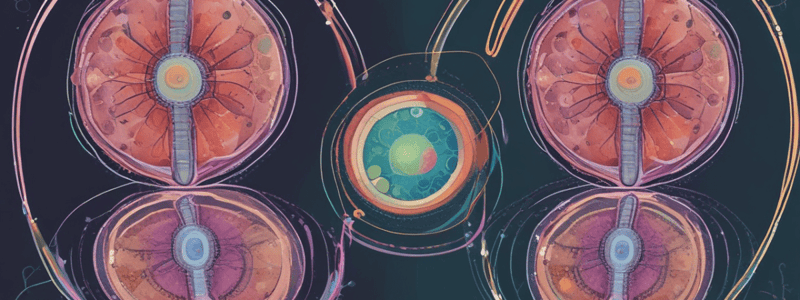Podcast
Questions and Answers
What is the primary use of benzodiazepines in pain management?
What is the primary use of benzodiazepines in pain management?
- Treating osteoporotic bone pain
- Releasing endorphins and enkephalins
- Sedating and reducing anxiety and muscle relaxation (correct)
- Relieving inflammation and swelling
What is the main cause of hemorrhagic stroke?
What is the main cause of hemorrhagic stroke?
- Untreated hypertension
- Vessel occlusion
- High cholesterol levels
- Ruptured vessel (correct)
What is the function of TENS in pain management?
What is the function of TENS in pain management?
- Stimulating nerves to reduce pain (correct)
- Releasing endorphins and enkephalins
- Sedating and reducing anxiety and muscle relaxation
- Relieving inflammation and swelling
What is the main risk factor for stroke?
What is the main risk factor for stroke?
What is the result of untreated hypertension in relation to stroke?
What is the result of untreated hypertension in relation to stroke?
What is the primary use of corticosteroids in pain management?
What is the primary use of corticosteroids in pain management?
What is the primary cause of ischaemic stroke?
What is the primary cause of ischaemic stroke?
What is the acronym that represents the signs of stroke?
What is the acronym that represents the signs of stroke?
What is the primary function of the endoplasmic reticulum?
What is the primary function of the endoplasmic reticulum?
During which phase of the cell cycle do extra organelles and DNA undergo replication?
During which phase of the cell cycle do extra organelles and DNA undergo replication?
What is the result of the combination of DNA from both parents during reproduction?
What is the result of the combination of DNA from both parents during reproduction?
What is the main function of lysosomes?
What is the main function of lysosomes?
What is the difference between free ribosomes and attached ribosomes?
What is the difference between free ribosomes and attached ribosomes?
What is the primary function of the Golgi apparatus?
What is the primary function of the Golgi apparatus?
How many stages does meiosis have?
How many stages does meiosis have?
What is the role of peroxisomes in the cell?
What is the role of peroxisomes in the cell?
What is the location of TSH receptors that causes exophthalmos and other ocular changes?
What is the location of TSH receptors that causes exophthalmos and other ocular changes?
What is the effect of primary hyperthyroidism on TSH levels?
What is the effect of primary hyperthyroidism on TSH levels?
What is the first-line therapy to reduce thyroid hormone levels?
What is the first-line therapy to reduce thyroid hormone levels?
What is a rare but dangerous worsening of the thyrotoxic state?
What is a rare but dangerous worsening of the thyrotoxic state?
What is the risk of permanent hypoparathyroidism after thyroidectomy?
What is the risk of permanent hypoparathyroidism after thyroidectomy?
What is the risk of recurrent laryngeal nerve damage after thyroidectomy?
What is the risk of recurrent laryngeal nerve damage after thyroidectomy?
What is the treatment for severe cases of Graves' disease?
What is the treatment for severe cases of Graves' disease?
What is the timeframe for mortality in untreated thyrotoxic crisis?
What is the timeframe for mortality in untreated thyrotoxic crisis?
What is the primary mechanism by which a pulse oximeter measures oxygen saturation?
What is the primary mechanism by which a pulse oximeter measures oxygen saturation?
What is the main difference between Type 1 and Type 2 respiratory failure?
What is the main difference between Type 1 and Type 2 respiratory failure?
What is the primary characteristic of obstructive airway diseases?
What is the primary characteristic of obstructive airway diseases?
What is the purpose of spirometry in diagnosing respiratory diseases?
What is the purpose of spirometry in diagnosing respiratory diseases?
What is the primary cause of the wheeze sound in patients with obstructive airway diseases?
What is the primary cause of the wheeze sound in patients with obstructive airway diseases?
What is the primary difference between acute and chronic respiratory failure?
What is the primary difference between acute and chronic respiratory failure?
What is the primary characteristic of restrictive airway diseases?
What is the primary characteristic of restrictive airway diseases?
What is the primary mechanism by which renal compensation occurs in respiratory failure?
What is the primary mechanism by which renal compensation occurs in respiratory failure?
What is the duration of CT scan in high-risk stroke patients?
What is the duration of CT scan in high-risk stroke patients?
What is the purpose of frequent monitoring of vital signs using ADDS score?
What is the purpose of frequent monitoring of vital signs using ADDS score?
What is the pharmacological management for ischaemic stroke?
What is the pharmacological management for ischaemic stroke?
What is the purpose of maintaining BP and BGL?
What is the purpose of maintaining BP and BGL?
What is the non-pharmacological management for stroke?
What is the non-pharmacological management for stroke?
Why is it important to keep the patient nil by mouth?
Why is it important to keep the patient nil by mouth?
What is the purpose of undertaking a nutritional status assessment?
What is the purpose of undertaking a nutritional status assessment?
What is the purpose of protecting the patient from injury?
What is the purpose of protecting the patient from injury?
Flashcards are hidden until you start studying
Study Notes
Cell Division
- Mitosis: a process that lasts for approximately 1 hour in a 24-hour cycle, consisting of 4 phases: Prophase, Metaphase, Anaphase, and Telophase.
- Interphase: a stage that occurs before and after cell division, where the cell grows, replicates its DNA, and prepares for cell division.
Meiosis
- A process of cell division that involves 2 cycles of cell division, resulting in 4 daughter cells with half the number of chromosomes as the parent cell.
- In human cells, meiosis results in 23 chromosomes in each gamete.
Endoplasmic Reticulum
- A membranous network attached to the nuclear membrane, involved in protein synthesis and transport.
- Consists of two types: rough endoplasmic reticulum (with ribosomes) and smooth endoplasmic reticulum (without ribosomes).
Ribosome
- The site of protein synthesis, composed of RNA and protein.
- Types of ribosomes: free ribosomes (floating in the cytoplasm) and attached ribosomes (bound to the endoplasmic reticulum).
Golgi Apparatus
- A network of flattened, smooth membranes involved in protein transport and modification.
- Receives proteins from the endoplasmic reticulum, modifies them, and packages them into vesicles for transport to other organelles or for secretion outside the cell.
Lysosomes
- Membrane-bound organelles containing digestive enzymes, responsible for breaking down and recycling cellular waste and foreign substances.
- Involved in apoptosis (programmed cell death).
Peroxisomes
- Small organelles similar to lysosomes, involved in detoxification and neutralizing free radicals.
Stroke (Cerebrovascular Accident)
- A medical condition caused by impaired blood flow to the brain, resulting in brain cell death.
- Types: Ischaemic stroke (blockage of a blood vessel) and hemorrhagic stroke (rupture of a blood vessel).
- Risk factors: age, gender, family history, hypertension, diabetes, high cholesterol, smoking, obesity, poor diet, lack of exercise, and atrial fibrillation.
Pathophysiology of Stroke
- Ischaemic stroke: blood clot blocks an artery, causing interruption of blood flow to the brain.
- Hemorrhagic stroke: rupture of a blood vessel, causing bleeding and increased pressure in the skull.
Signs of Stroke
- Face: drooping, numbness, or weakness on one side of the face.
- Arms: weakness or numbness in one arm.
- Speech: difficulty speaking or understanding speech.
- Time: act F-A-S-T and call for medical help immediately.
Management of Stroke
- Frequent monitoring of vital signs and neurological function.
- Maintaining blood pressure and blood glucose levels.
- Preventing pressure sores and injuries.
- Non-pharmacological management: carotid endarterectomy, thrombectomy, dietary plan, smoking cessation, and regular exercise.
Respiratory Failure
- A condition where the lungs are unable to take in enough oxygen or remove enough carbon dioxide.
Causes of Respiratory Failure
- Acute: life-threatening derangements in arterial blood gases and acid-base status.
- Chronic: less dramatic, with pH levels possibly being normal due to renal compensation.
Disorders of the Pulmonary System
- Obstructive airway diseases: asthma, COPD, cystic fibrosis, and bronchiectasis.
- Restrictive airway diseases: ARDS, idiopathic pulmonary fibrosis, and interstitial lung disease.
Diagnosis and Treatment of Thyroid Disorders
- Diagnosis: measuring free thyroxine (T4) and free triiodothyronine (T3) levels.
- Treatment: symptom control, reducing thyroid hormone levels using antithyroid medications, radioactive iodine therapy, or surgery.
Thyrotoxic Crisis
- A rare but life-threatening condition that occurs in individuals with undiagnosed or partially treated Graves' disease, characterized by fever, tachycardia, and cardiac decompensation.
Studying That Suits You
Use AI to generate personalized quizzes and flashcards to suit your learning preferences.





